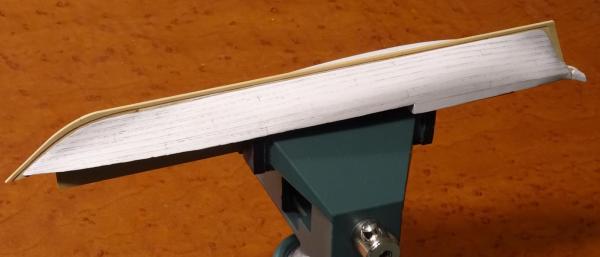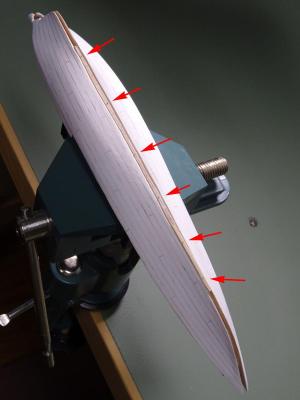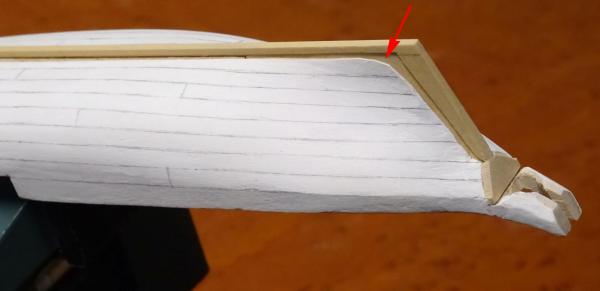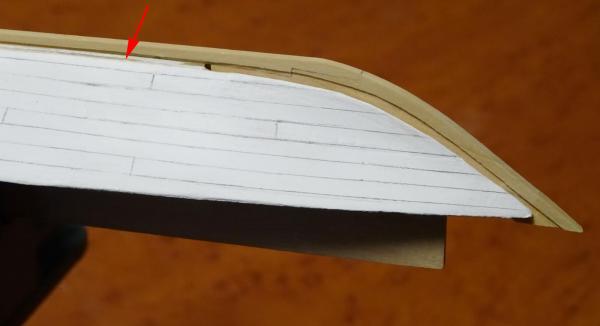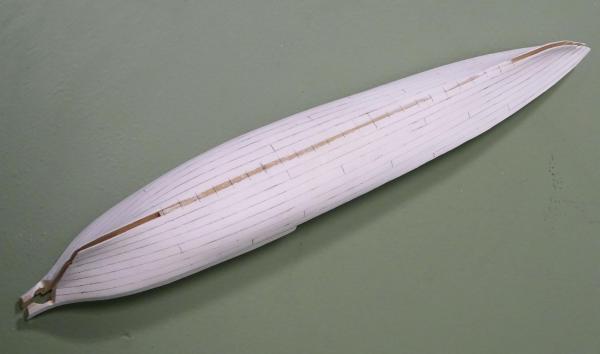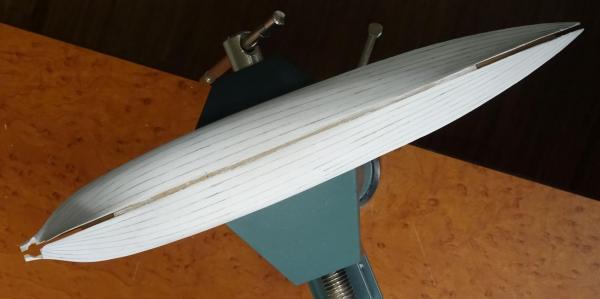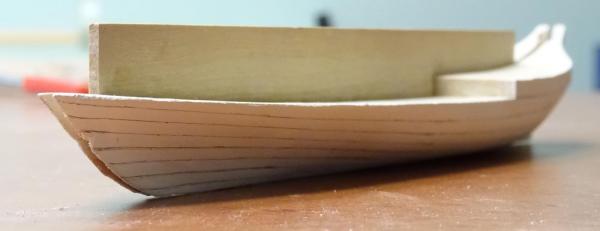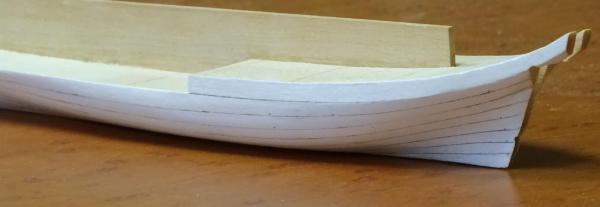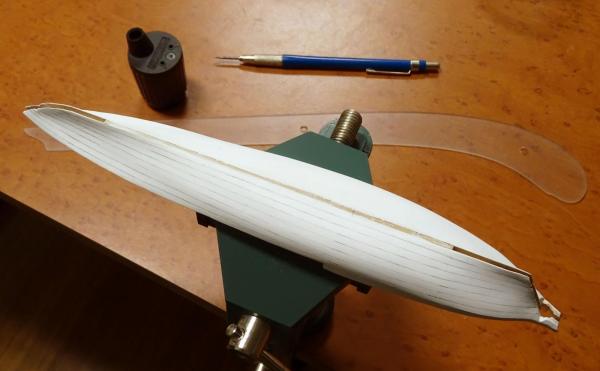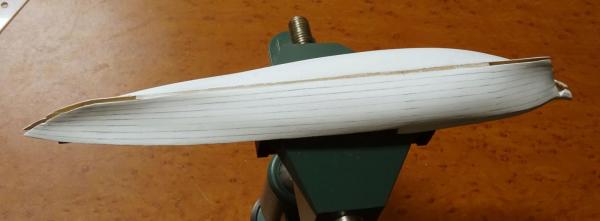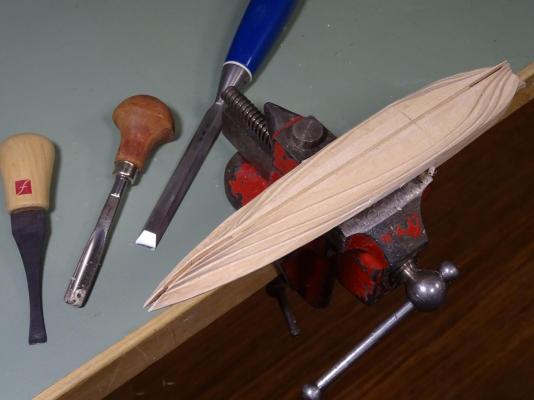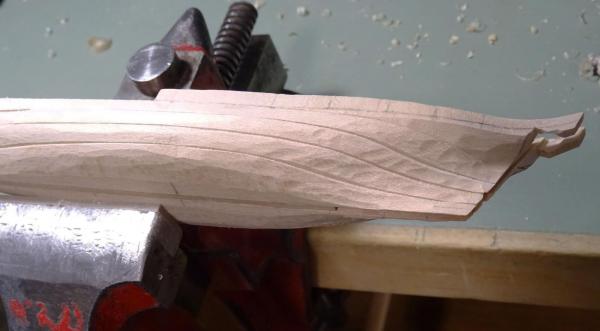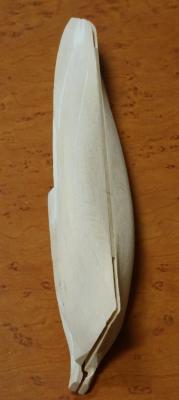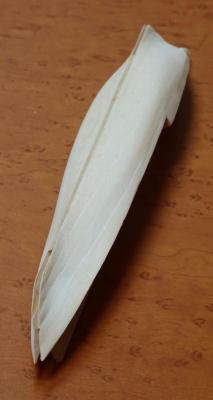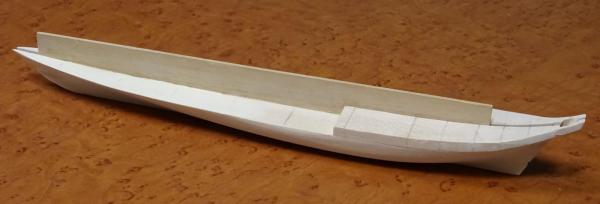-
Posts
13,375 -
Joined
-
Last visited
Content Type
Profiles
Forums
Gallery
Events
Everything posted by druxey
-
Looking good, but has the fore end of the coaming come adrift?
- 258 replies
-
- buzzards bay
- herreshoff
-
(and 1 more)
Tagged with:
-
A small update: Before waxing the plug, I drew in the overlaps of the clinker planking. I made them 1" wide and are seen as dashed lines on the plug. Two coats of Clapham's beeswax polish were used over the mark-out. Leaves of ¾" thick Castello have now been prepared for the planking. They were cut a little over-thick and then taken down almost to spec on a thickness sander. Finer grades of sandpaper on sanding blocks produced a smooth surface. Hopefully there will be time to commence planking soon.
- 641 replies
-
- greenwich hospital
- barge
-
(and 1 more)
Tagged with:
-

ancre Le Fleuron 1729 by rekon54 - 1:24
druxey replied to rekon54's topic in - Build logs for subjects built 1501 - 1750
Lovely details! -
Quite the forest of ventilators!
- 2,625 replies
-
- kaiser wilhelm der grosse
- passenger steamer
-
(and 1 more)
Tagged with:
-

Echo by Maury S - FINISHED - Cross-Section
druxey replied to Maury S's topic in - Build logs for subjects built 1751 - 1800
That's a different kind of display case and works wonderfully. Well done, Maury.- 324 replies
-
Well, there's been a little progress made between other projects. I decided to revise the scheme of planking butts and I'm happier with the new layout. The plug has been cut back along the central spine (arrowed) to ensure that it will not become accidentally glued to the plug while planking. The tiny transom has also been added and bevelled to conform to the plug's contours. The overall photo shows six small brass pins in place to secure the keel while installing the garboard strakes. Next up will be to wax the plug, then cut some very thin planking stock to ¾" thickness.
- 641 replies
-
- greenwich hospital
- barge
-
(and 1 more)
Tagged with:
-
Like Michael, I've followed your work over many years, after stumbling across pictures of your tulipwood Hispano Suiza and one of your books. Thank you for sharing this project with us.
- 281 replies
-
- falls of clyde
- tanker
-
(and 2 more)
Tagged with:
-
After some re-working of the planking runs, I've devised a scheme for the shift of the butts and marked these on the plug. Now that the 'non-boat' work is almost complete, it's time to get back to the actual model. I needed to devise a method of keeping the keel straight on the plug. If not stabilized, it will deflect as I fit the garboard strake. My solution is to drill small holes at intervals along the plug, then set sharp-ended pieces of hard brass wire, points uppermost. The keel will be pressed down onto these points. The resulting holes will be hidden under the keelson later on.
- 641 replies
-
- greenwich hospital
- barge
-
(and 1 more)
Tagged with:
-
Ah! Another Saturday 'fix' - I mean update on your exquisite work for us to enjoy. Thanks, Glenn.
-

Cutter Cheerful 1806 by rafine - FINISHED
druxey replied to rafine's topic in - Build logs for subjects built 1801 - 1850
Very nicely accomplished Bob.Well done!- 525 replies
-
- cheerful
- Syren Ship Model Company
-
(and 1 more)
Tagged with:
-
Interesting comparisons, Jerry. But here's a counter-argument to consider: Say you build your model from maple and the outlay is $40.00 (I figure that there will be quite a few 'makeover' bits, so two boards). Pear might cost twice as much. A Bonnehomme Richard model will probably take you 2000 hours to build. Amortize this in cents/hour. That's about 2c for the maple and 4c for pear. Pear or another specie of wood isn't such a huge investment when looked at that way, especially when you invest so much of your time and skill.
-
Lovely miniature metalwork, Ed. The third hands and rotating ceramic plate are a nice sophistication over earlier fixed base soldering stations.
- 3,618 replies
-
- young america
- clipper
-
(and 1 more)
Tagged with:
-
Thanks, Siggi. The barge is displayed much better than it used to be years ago. Fortunately the Greenwich Hospital barge has nowhere nearly as much carved work!
- 641 replies
-
- greenwich hospital
- barge
-
(and 1 more)
Tagged with:
-
Thanks, Siggi. I do have some photos of that barge, but if you have some you'd like to share.... Update: I had to rework the forward hull, as I'd omitted to remember that the sheer strake narrows almost to a point at the bow. Both sides of the plug are now lined out to my satisfaction and have been checked by viewing from all angles. It always surprises me that lines that look sweet from one angle look awful when viewed from another! Several re-works were required before arriving at what you see in the photos. I may spot more minor adjustments to make before committing myself to the plan.
- 641 replies
-
- greenwich hospital
- barge
-
(and 1 more)
Tagged with:
-
Hah! Maury, have you not noticed how carefully the photos are framed and cropped?
- 641 replies
-
- greenwich hospital
- barge
-
(and 1 more)
Tagged with:
-
Congratulations on completing Dragon, Siggi! She looks terrific and those delicate hammock cranes are very neatly done.
-
Gesso dries fairly quickly, fills grain and sands well, Nigel. It also takes pencil easily. Certainly it does not prevent adhesion without some form of varnish or wax over the plug, but that's later in the process.
- 641 replies
-
- greenwich hospital
- barge
-
(and 1 more)
Tagged with:
-

Seeking information on determining load waterline
druxey replied to trippwj's topic in Nautical/Naval History
Don't forget the 'anonymous' of c.1600 whose manuscript of Propositions Newton copied out! -
Now things start to get interesting. The plug was repeatedly gessoed and rubbed down to a smooth surface. The next step is to line out the planking. There are two stages to this process. The first is mechanical: dividing the surface into equal parts at various points along the hull. In this case the draught showed eight strakes. The distance around half the hull at the dead flat was exactly 4' 0", so each stroke is 6" wide at that point. Once the hull has been divided into 8 bands or strakes, these need to be finessed so that, no matter from which direction you look at it, the planking runs smoothly to the eye. The bow-most third of the hull gave the most difficulty, as there is a pronounced hollow to the form. In some cases the variation of the thickness of the pencil line (very thin) was enough to make the difference. In others the line had to be moved by as much as 1/32". I may still play with the layout a little more before I'm completely satisfied. The layout at present makes no allowance for overlaps of the clinker planks - that will come later, as will the shift of plank butts.
- 641 replies
-
- greenwich hospital
- barge
-
(and 1 more)
Tagged with:
-
I was able to put in some more time on carving and refining the plug. The initial shaping was done with chisel and gouges, then smoothed with various grades of sandpaper. The sleek and streamlined form, dimensioned to the inside of the planking is almost complete. The form at the stern up to the transom was the trickiest part of the shaping. At both bow and stern, the plug is paper thin. Later this will be cut away to prevent the planks from adhering. Next, when time allows, will be further sanding and smoothing of the plug's surface with gesso.
- 641 replies
-
- greenwich hospital
- barge
-
(and 1 more)
Tagged with:
About us
Modelshipworld - Advancing Ship Modeling through Research
SSL Secured
Your security is important for us so this Website is SSL-Secured
NRG Mailing Address
Nautical Research Guild
237 South Lincoln Street
Westmont IL, 60559-1917
Model Ship World ® and the MSW logo are Registered Trademarks, and belong to the Nautical Research Guild (United States Patent and Trademark Office: No. 6,929,264 & No. 6,929,274, registered Dec. 20, 2022)
Helpful Links
About the NRG
If you enjoy building ship models that are historically accurate as well as beautiful, then The Nautical Research Guild (NRG) is just right for you.
The Guild is a non-profit educational organization whose mission is to “Advance Ship Modeling Through Research”. We provide support to our members in their efforts to raise the quality of their model ships.
The Nautical Research Guild has published our world-renowned quarterly magazine, The Nautical Research Journal, since 1955. The pages of the Journal are full of articles by accomplished ship modelers who show you how they create those exquisite details on their models, and by maritime historians who show you the correct details to build. The Journal is available in both print and digital editions. Go to the NRG web site (www.thenrg.org) to download a complimentary digital copy of the Journal. The NRG also publishes plan sets, books and compilations of back issues of the Journal and the former Ships in Scale and Model Ship Builder magazines.



